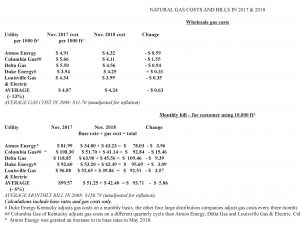Kentucky residents who heat their homes with natural gas will see somewhat lower prices at the start of the 2018-2019 heating season than they did a year ago, according to a statement from the Kentucky Public Service Commission (PSC).
Natural gas prices have fallen, on average, about 13 percent from this time last year, and are now about 64 percent below their level ten years ago.
When base rates – which include monthly customer charges and delivery fees – are factored in, Kentucky residential customers can, on average, expect their total gas bills to be about 6 percent lower this November than last, based on heating season consumption of 10,000 cubic feet of natural gas per month. The average total bill for 10,000 cubic feet – including gas costs and base rates, but not miscellaneous charges and credits – is projected to be about $93.71.
That is down $5.92 from last year and a decrease of about $57 since November of 2008, when the average price per 1,000 cubic feet was $11.70. The figures are not adjusted for inflation. The lower cost of natural gas has more than offset increases in base rates over that time and now represents less than half of the average total residential bill, or $42.40 of the $93.71 total.
“Ample production of natural gas is continuing to forestall any sharp increases in prices,” said PSC Chairman Michael Schmitt. “Even with higher demand due to greater use of natural gas to generate electricity and rising gas exports, the supply has more than kept pace.”
Weather determines the amount of energy that consumers use to heat their homes and thus is the major factor in the size of their heating bills, Schmitt said.
“Kentucky is forecast to have normal winter temperatures this year,” said Schmitt. “That would be a welcome change from last winter, when several months of colder-than-normal weather pushed energy bills higher.”
Whatever the weather or the cost of natural gas, Schmitt said consumers would still benefit by taking steps to reduce consumption.
“Low natural gas prices present an opportunity to turn those savings into investments in permanent improvements, such as weatherization, that will insulate homeowners against higher energy costs in the future,” Schmitt said.
The lower cost of gas means that base rates are now a larger portion of the total bill. Only one of Kentucky’s five large natural gas distribution companies received a base rate increase in the last 12 months.
Consumers also will be helped by credits that pass through the savings that the five natural gas distribution utilities are seeing as the result of a reduction in federal corporate income taxes that took effect this year, Schmitt said. The PSC recently completed its review of the rate impacts of the tax reduction and ordered utilities to return the savings to their customers.
Changes in individual ratepayer bills will vary by company and customer usage.
Wholesale prices over the last nine years have not approached the peak prices seen during a sharp upward turn in 2008. Prices declined even more abruptly during the economic downturn in 2009, and have stabilized at a much lower level due to an increase in supplies.
The commodity cost of natural gas is passed through to consumers on a dollar-for-dollar basis by local distribution companies.
By federal law, natural gas prices are not regulated at the wholesale level and generally fluctuate with supply and demand. Under Kentucky law, gas utilities are entitled to recover the wholesale cost of the gas delivered to their customers, including the fees they pay to interstate pipelines to transport the gas to their retail distribution systems. However, gas utilities are not allowed to earn a profit on their gas commodity costs. The companies’ gas cost adjustments are reviewed by the PSC to make sure they accurately reflect the actual cost of natural gas.
The projected monthly bill is an average for Kentucky’s five major local natural gas distribution companies as of November. It will change as companies make further wholesale cost adjustments throughout the heating season.
Wholesale costs and base rates vary by company. The base rates reflect a utility’s day-to-day operating costs, including the cost of delivering gas, as well as a return on equity for company shareholders.
The five major natural gas distribution companies in Kentucky are Atmos Energy, Columbia Gas of Kentucky Inc., Delta Natural Gas Co. Inc., Duke Energy Kentucky Inc., and Louisville Gas and Electric Co. Together the five companies serve more than 750,000 customers in Kentucky and deliver about 176 billion cubic feet of gas annually.
About 44 percent of Kentuckians heat their homes with natural gas. Those who heat with propane (10 percent) should see stable prices, while users fuel oil (3 percent) will see an increase of about 20 percent over last year, according to the U.S. Energy Information Administration.
For the 39 percent of Kentuckians who use electric heat, changes in heating costs are likely to be driven by fluctuations in fuel costs, environmental compliance costs and other items that change on a monthly basis, as well as base rate adjustments for several utilities over the last year.
Although fuel prices have been relatively stable in recent years, many Kentuckians still struggle to pay their heating bills, Schmitt noted. Heating assistance is available from local community action agencies and from utility companies, but funds are limited and sometimes run out during the heating season, he said.
“Do not wait to act until you are in a crisis and in danger of losing utility service,” Schmitt said. “If you anticipate difficulties in paying your heating bill this winter, now is the time to find out where you might be able to receive assistance.”
The PSC is an independent agency attached for administrative purposes to the Energy and Environment Cabinet. It regulates more than 1,100 gas, water, sewer, electric and telecommunication utilities operating in Kentucky.


















